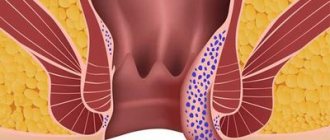Surgery to remove hemorrhoids is a radical treatment method for an unpleasant and difficult pathology.
Surgical intervention is intended for patients with chronic forms of dilatation of the rectal veins, as well as during their acute course.
Modern experts always recommend conservative treatment methods to patients, but if after this the patient does not experience improvement, then surgical removal of the nodes is urgently prescribed. When acute hemorrhoids develop, patients are always prescribed surgery.
The operation is prescribed as a last resort. First, doctors carry out all possible therapeutic measures - eliminate inflammatory processes and stabilize the patient’s condition. Only after this can a decision be made about the operation.
What is the essence of “laser” treatment for hemorrhoids?
Laser treatment is otherwise called “vaporization”. It is based on the fact that a high-temperature beam is precisely directed at the tissue that needs to be removed. At the same time, the laser beam burns the tissue and cuts it exactly where it is needed.
The laser beam promotes faster scarring of the postoperative wound, which is why the recovery period proceeds much faster.
Surgeons may use one of these types of varicose vein removal.
- Transmucosal laser vaporization (evaporation). This removes the blood vessels supplying the hemorrhoid.
- Subdermal-submucosal cauterization (by internal action on the affected hemorrhoid).
- Evaporation with sclerosant.
The choice of a specific treatment method will be possible only after a thorough examination of the patient.
Indications for traditional surgical methods
Surgical removal of chronically enlarged hemorrhoids is performed when minimally invasive techniques are technically difficult to implement or are doomed to failure due to the increased risk of relapse.
The most popular indications for excision with a scalpel: • Stage IV of the disease (nodes cannot be moved into the rectal cavity); • Stage III with large nodes (hemorrhoids can be reduced by hand in a warm bath); • a significant number of pathological elements; • presence of complications (necrosis, thrombosis, bleeding, etc.).
The decision to perform surgical excision is made on an individual basis. This takes into account the condition of the terminal intestine and adjacent organs, as well as the age and general health of the patient. To clarify all the data, it will be necessary to undergo a diagnostic examination.
Examination before surgery
As a rule, before laser removal of hemorrhoids, the patient must undergo the following examinations:
- general examination of blood and urine;
- test for blood glucose levels;
- electrocardiographic examination;
- fluorography;
- for women, you additionally need to undergo a gynecological examination;
- anoscopy (examination of the anus);
- sigmoidoscopy (examination of the rectum and some parts of the sigmoid colon using a special device - a sigmoidoscope).
Additionally, examinations such as endoscopic examination of the large intestine, ultrasound of the abdominal organs, tomography, etc. may be required.
Diagnostics
Diagnosis of hemorrhoids is necessary to establish the number and location of pathological elements, the presence of complications and concomitant diseases of the rectum.
Enlarged hemorrhoids are quite often combined with other pathologies: • anal fissure • proctitis (inflammation of the mucous membrane of the terminal intestine); • rectal polyps; • malignant tumor.
The necessary amount of information can be obtained using sigmoidoscopy. If there is a suspicion of damage to the overlying parts of the large intestine, a colonoscopy is performed.
If the proctologist decides on surgical intervention, all standard examinations will be needed: • general urine and blood tests, • coagulogram, • tests for blood-borne infections, • ECG, consultation with a therapist, anesthesiologist and gynecologist (for women).
Diet table
A few days before the removal of hemorrhoids, the patient must adjust his diet.
Table 1. Diet before surgery
| Products | What is allowed | What is prohibited | What to eat the day before surgery |
| Liquid soups, water-based porridges, vegetable stews and fermented milk products | Fatty, fried, spicy and salty foods, black bread, white cabbage, chocolate and other sweets, as well as all dishes that can cause constipation | You need to have a light dinner (for example, kefir or light yogurt). On the day of surgery, in the morning, eating is prohibited. |
Recovery period
Depending on the surgical method, the patient may remain in the hospital for 3 to 7 days. In some cases of closed hemorrhoidectomy, discharge from the hospital is possible after the doctor makes sure that urine flows freely. Further treatment is carried out at home under the supervision of a doctor until complete recovery.
The rehabilitation period includes a protective regime and an intestinal-friendly diet. In the first days after surgery, you should not be in a sitting position, and heavy physical activity is also prohibited. You should avoid rough, spicy, salty foods and alcohol.
For the speedy healing of a postoperative wound, it is necessary to strictly follow the rules of hygiene (washing after each bowel movement), as well as use all local medications recommended by the doctor (ointments and suppositories).
An important condition for preventing complications is normalizing stool. Bowel movements should be regular, preferably daily. If necessary, use mild laxatives.
How does the removal work?
Laser hemorrhoid removal is performed on an outpatient basis under local anesthesia. Lidocaine cream is applied before the local anesthetic is administered. If the patient is allergic to novocaine or lidocaine, then general anesthesia is used.
The patient is in the knee-elbow position on a couch or on a gynecological chair. Before using the laser beam, the area undergoing surgical treatment is treated with an antiseptic solution.
Types of hemorrhoids
Hemorrhoids are divided into internal and external. Internal hemorrhoids, as their name suggests, are located inside the anal canal. Clinically, they usually manifest as rectal bleeding, and as the disease progresses, prolapse (prolapse) of hemorrhoids. External hemorrhoids are located in the anus, usually manifested by swelling of the hemorrhoids, inflammation, and thrombosis. Often complicated by anal fissures.
Stages of implementation
The patient must come to the doctor on the appointed day and time. He undresses to the waist and puts on disposable shorts with a hole in the appropriate place. The stages of the procedure are as follows.
- The doctor administers a local anesthetic to the patient by injection in the anal area. The local anesthetic begins to take effect within a few minutes.
- Then the doctor removes the nodes layer by layer using a laser. In this case, there is practically no bleeding, because the laser simultaneously burns out the veins.
- During the operation, an anoscope with built-in illumination is used. It is necessary to monitor all actions.
- After discovering the location of the node's stem, the hemorrhoidal node is burned out.
- If there is only one growth, then the operation is completed. If the nodes remain, the doctor can remove a maximum of two more.
The patient needs to rest for approximately 40 minutes after completing the procedure. He can't get up. During this time, the doctor monitors the patient the entire time the anesthesia is in effect.
Minimally invasive therapeutic interventions
Ligation of the node with latex rings
Indicated for internal hemorrhoids, when the nodes often fall out during bowel movements, but are able to be reduced on their own. Using a special device, a latex ring is put on the node, which presses on the leg of the node, after which the hemorrhoidal node disappears. Contraindications for ligation are allergy to latex, portal hypertension, patients constantly taking anticoagulants, inflammation and fissures in the rectum.
Sclerotherapy for hemorrhoids
Sclerotherapy is performed in case of bleeding of hemorrhoids without prolapse. It is carried out by injecting sclerosing drugs into the hemorrhoidal vessels. The injected drugs cause sclerosis of the hemorrhoid and its subsequent rejection. In some cases, sclerotherapy is performed as a preparatory procedure before hemorrhoidectomy. Sclerotherapy is contraindicated for inflammatory diseases of the anorectal area. During the procedure, severe pain may occur.
Infrared photocoagulation
Infrared coagulation is performed by exposing a powerful beam of light energy to the base of the hemorrhoid. The result of the procedure is coagulation of the node followed by its resorption. This type of treatment is indicated in the presence of bleeding from the nodes, without their loss. During the procedure, pain of varying intensity may occur. Complications of this type of treatment: bleeding, infection of the anal area and urinary retention.
Hemorrhoidectomy
Radical hemorrhoidectomy is a classic surgical treatment for hemorrhoids. The operation is performed by surgically excising the hemorrhoids. Hemorrhoidectomy is indicated for advanced cases of hemorrhoids (prolapsed, non-reducible nodes) and in the absence of effect from minimally invasive treatment. Unlike minimally invasive methods of treating hemorrhoids, this operation is a traumatic type of treatment and is accompanied by a long recovery period. At the same time, the wound takes a long time to heal and pain persists, and patients experience discomfort during bowel movements. Complications of surgical treatment include narrowing of the anus, disruption of the sphincter (its weakness) and wound infection.
Desarterization of hemorrhoids
The essence of the operation is to reduce the blood supply to the hemorrhoidal plexus area by ligating the arteries. The effectiveness of the operation largely depends on the completeness of all arteries in a given area and their high-quality ligation. Requires highly qualified specialists and expensive equipment. In addition, for a number of reasons listed below, relapse cannot be ruled out.
Possible complications
Laser treatment for hemorrhoids is safe for health. However, after surgery, the following complications may occur:
- bleeding due to insufficient cauterization of blood vessels or insufficient diet;
- partial thrombosis of the node due to insufficient vaporization of the blood vessel;
- wound infection due to insufficient anal hygiene;
- recurrence of hemorrhoids (the laser beam cannot affect the cause of the disease).
Recurrence of hemorrhoids is very rare. This mainly happens if the patient does not adhere to the doctor’s recommendations (does not fight constipation, moves little, drinks alcoholic beverages and smokes).
Some men, due to anatomical features, may experience urinary retention. In serious cases, doctors install a catheter.
If hemorrhoids are not completely removed, then the person has an increased likelihood of a chronic, sluggish inflammatory process.
Preparatory and operational period
Before the operation, the patient must fulfill certain conditions, namely: pass all the necessary tests, undergo a diagnosis of concomitant pathologies, and undergo a consultation with a therapist to determine possible contraindications.
The preparatory stage consists of complete bowel movement. Cleansing is carried out on the eve of the operation and immediately before the procedure itself.
A similar procedure is carried out using an enema and laxative medications. It is also worth paying special attention to nutrition in order to normalize all functions of the intestine and its walls. It is necessary to restore normal stool. This is a mandatory condition, since constipation during removal of hemorrhoids can cause serious complications. Let us remember that constant constipation is the first step to the development of hemorrhoids.
Before surgery, it is very important to relieve the inflammatory process in the anus, if it is present, of course. It is also worth relieving irritation and swelling. This can be done with the help of medications and traditional medicine.
Rehabilitation after surgery
After removal of the hemorrhoid, the recovery period begins. For a week after removal of the node, you should avoid exercise and lifting heavy objects. You should not use toilet paper: you should replace it with washing. You can add a little potassium permanganate to the washing solution.
After removing hemorrhoids using a laser beam, you may feel pain. To relieve it, the doctor prescribes anesthetic ointments and suppositories. To speed up the healing of the operated area, rectal suppositories containing sea buckthorn oil or methyluracil are used. For severe pain, Nurofen or Ibuklin are recommended. The patient must remember that pain may return within 3 weeks after the intervention.
Contraindications
• Surgery will have to be postponed for any acute illness or exacerbation of a chronic illness . • Severely obese are first advised to lose weight. • Hemorrhoids during pregnancy are treated conservatively, since there is a high probability of healing after the end of the child's feeding period. • Some relative contraindications may be: ___• blood clotting disorders; ___• colon oncology; ___• diabetes; ___• cirrhosis of the liver; ___• unstable angina; ___• recovery period after injuries, operations, etc.
Surgical intervention can be performed after stabilization of the condition and consultation with a medical specialist (cardiologist, endocrinologist, hematologist, hepatologist, etc.).
It must be remembered that only a doctor can assess the indications and contraindications and decide on the need for surgery. If you have questions about choosing a treatment method, be sure to consult a proctologist!
Benefits of laser hemorrhoid removal procedure
Removing hemorrhoids using a laser beam has the following advantages:
- this surgical intervention can be performed on an outpatient basis or in a day hospital; within a few hours the patient can go home;
- general anesthesia is not necessary (except in cases where the patient is allergic to anesthetic drugs administered locally);
- the laser beam acts very accurately and targetedly, only on the affected area, almost without affecting nearby tissues and without having a systemic effect on the body;
- the duration of the entire operation does not exceed 20 minutes;
- the operation can be performed at any stage of hemorrhoids;
- the procedure does not cause bleeding;
- after laser removal there are no scars or stitches;
- the doctor may prescribe vaporization in cases where other treatment methods are ineffective;
- with the help of such an operation it is possible to treat other diseases at the same time;
- pain after laser removal occurs rarely and is not expressed;
- restrictions after treatment are minimal.
Recommended video:
Treatment of hemorrhoids using a laser beam is a modern and effective technique that allows you to improve the patient’s condition in a short time. The procedure is virtually painless and rarely causes complications. The patient needs to be very careful during the postoperative period, as well as adhere to the rules of a healthy lifestyle.
Some accompanying interventions performed during hemorrhoidectomy
Sometimes, with severe hypertonicity of the anal sphincter, or in the presence of a chronic anal fissure, hemorrhoidectomy can be supplemented with sphincterotomy. The essence of this intervention is partial dissection of the fibers of the internal sphincter in order to relieve muscle spasm and create normal conditions for complete healing of postoperative wounds.
As a rule, a dosed lateral, closed sphincterotomy is performed. This is a fairly rare intervention and is performed in exceptional cases and this manipulation is discussed with the patient beforehand. We have a negative attitude towards this manipulation, because... this increases the risk of incontinence, i.e. fecal incontinence.
Why is hemorrhoidectomy necessary?
Your doctor may recommend a hemorrhoidectomy to treat advanced hemorrhoids that cause pain and bleeding from the rectum. Hemorrhoidectomy is indicated when other less invasive treatments cannot be performed or may be less effective.
When choosing surgery, you should discuss other treatment options with your doctor and, if necessary, seek the opinion of another specialist before deciding on surgery.
How can a hemorrhoidectomy affect my daily life?
Hemorrhoidectomy (surgery to remove hemorrhoids, hemorrhoids) will relieve you of the symptoms of hemorrhoids, or significantly reduce them. Hemorrhoidectomy is a radical intervention, i.e. solves the problem completely. But, nevertheless, you need to make some changes in your life that can help you avoid recurrence of hemorrhoids and rectal problems in the future:
- To drink a lot of water.
- Choose diets high in fiber.
- Adequate physical activity.
- Maintaining a healthy weight.
- Go to the toilet when you feel the urge to defecate (preferably in the morning after breakfast).
- Take dietary fiber and laxatives as recommended by your doctor if you have constipation.
What questions should you ask your doctor before your planned surgery?
Any surgical intervention is stressful for a person, therefore, in order not to forget anything, you need to prepare a list of questions for the doctor in advance.
Key questions to ask your doctor:
- Why is hemorrhoidectomy necessary? Are there other options for treating hemorrhoids?
- What type of hemorrhoidectomy surgery will I need?
- How long does the operation take? When can I return home?
- What restrictions will I have after surgery? When can I return to work and other activities?
- What help will I need at home? How should I take my medications?
- How will you treat my pain after surgery? When should I come for an examination?
- How can I contact you? Ask for numbers so you can contact them after work.
- What complications can happen after hemorrhoidectomy?
- Knowledge of the postoperative period, an appropriate attitude, and strict adherence to the doctor’s recommendations will make the recovery period after hemorrhoidectomy smoother.
- How long will the recovery period last?
Why hemorrhoids occur and external hemorrhoids form
The main causes of the disease are stagnation of blood in the pelvis and straining, causing increased intra-abdominal pressure and increased load on the veins of the hemorrhoidal plexus. As a result, the vessels stretch, lose tone and hemorrhoids appear.
Stagnation occurs in the cavernous plexus, a swelling area shaped like a ring and located above the anus.
The development of the disease leads to weakening of the muscles and ligaments of the rectum, which increases the protrusion of hemorrhoids. As a result, during defecation, dilated veins burst and bleeding occurs - a sign of hemorrhoids.
External hemorrhoids are an extreme form of the disease. The only thing that could be worse is complications. The larger the hemorrhoid, the more problems it brings. Small nodes without treatment quickly enlarge, increasing the risks.
The disease is provoked by:
- Excess weight.
- Sitting on a chair for long periods of time while working.
- Poor diet leading to constant constipation.
- Drinking alcoholic beverages, especially with spicy and pickled foods.
- Sedentary lifestyle.
- Lifting weights, doing strength sports. The disease also occurs in lovers of horse riding, motorcycles, and cycling.
- Abuse of enemas and laxatives.
- Anal sex.
- Insufficient hygiene of the area around the anus.
If a prolapsed external hemorrhoid appears, the proctologist recommends its excision.







